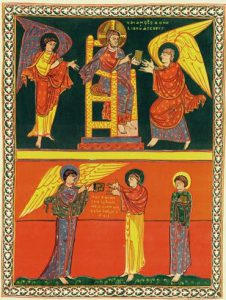 The Book of the Revelation, Philip E. Hughes. Pillar New Testament Commentary. Grand Rapids: Eerdmans, 1990. 242 pp.
The Book of the Revelation, Philip E. Hughes. Pillar New Testament Commentary. Grand Rapids: Eerdmans, 1990. 242 pp.
Hughes’s commentary on Revelation is not widely known, probably because it has gone out of print. I have found his commentary on Hebrews to be so helpful that I was quick to check out his work on Revelation after I became aware of it. The great strength of Hughes’s work is its attention to connections between Revelation and New Testament theology. It is common for commentaries to draw connections between Revelation and the Old Testament or the other works of John. Often, however, commentaries make fewer connections with the rest of the New Testament and shy away from making too many theological observations. Whenever I was wondering about how to connect Revelation to New Testament theology, I found myself looking for the Hughes volume. For example, Revelation 7:14 talks about the saints washing their robes and making them white in the blood of the Lamb. Hughes is quick to clarify how the washing of the robes is related to biblical and New Testament theology (98). He discusses the washing of their robes in relation to receiving the benefits of the cross. Hughes lists several Old Testament and New Testament references in his brief discussion (Is. 64:6, Ps. 14:3, Rom. 3:9ff., and 1 John 1:7). Although this point seems obvious, I actually did not find much theological reflection related to the washing of the saints robes in Revelation 7:14 and 22:14. Hughes provides a surprising number of helpful theological comments in his brief volume. Many people have asked me to recommend a shorter commentary on Revelation. Hughes is one of the more helpful commentaries on Revelation that is less than 250 pages.
Hughes’s Overall Approach to the Book of Revelation
With respect to the millennium, Hughes is amillennial. Like some other amillennial interpreters, it is not always clear what belongs to the future versus what has already begun in the present. The best example of this is generally the 21 plagues, that is, the 7 seals, 7 trumpets, and 7 bowls. Although he is not exactly clear about his view, it appears that he thinks that each series of seven begins and ends at the same place, that is, each series begins sometime after the exaltation of Jesus and continues until the seventh plague brings final judgment (87, 105, 108). As a result, it appears that he would see these plagues as in progress now. Other than the seventh and final plague, he is not entirely clear about what other plagues might belong exclusively to the future. Along these lines, the 3½ year persecution of the church by the Beast is not exclusively future either. It would appear to be the time period in between the first and second comings of Jesus (122-3). I happen to agree with Hughes on this point.
The Book of the Revelation by Philip E. Hughes
Hughes’s commentary on Revelation is not widely known, probably because it has gone out of print. I have found his commentary on Hebrews to be so helpful that I was quick to check out his work on Revelation after I became aware of it. The great strength of Hughes’s work is its attention to connections between Revelation and New Testament theology. It is common for commentaries to draw connections between Revelation and the Old Testament or the other works of John. Often, however, commentaries make fewer connections with the rest of the New Testament and shy away from making too many theological observations. Whenever I was wondering about how to connect Revelation to New Testament theology, I found myself looking for the Hughes volume. For example, Revelation 7:14 talks about the saints washing their robes and making them white in the blood of the Lamb. Hughes is quick to clarify how the washing of the robes is related to biblical and New Testament theology (98). He discusses the washing of their robes in relation to receiving the benefits of the cross. Hughes lists several Old Testament and New Testament references in his brief discussion (Is. 64:6, Ps. 14:3, Rom. 3:9ff., and 1 John 1:7). Although this point seems obvious, I actually did not find much theological reflection related to the washing of the saints robes in Revelation 7:14 and 22:14. Hughes provides a surprising number of helpful theological comments in his brief volume. Many people have asked me to recommend a shorter commentary on Revelation. Hughes is one of the more helpful commentaries on Revelation that is less than 250 pages.
Hughes’s Overall Approach to the Book of Revelation
With respect to the millennium, Hughes is amillennial. Like some other amillennial interpreters, it is not always clear what belongs to the future versus what has already begun in the present. The best example of this is generally the 21 plagues, that is, the 7 seals, 7 trumpets, and 7 bowls. Although he is not exactly clear about his view, it appears that he thinks that each series of seven begins and ends at the same place, that is, each series begins sometime after the exaltation of Jesus and continues until the seventh plague brings final judgment (87, 105, 108). As a result, it appears that he would see these plagues as in progress now. Other than the seventh and final plague, he is not entirely clear about what other plagues might belong exclusively to the future. Along these lines, the 3½ year persecution of the church by the Beast is not exclusively future either. It would appear to be the time period in between the first and second comings of Jesus (122-3). I happen to agree with Hughes on this point.